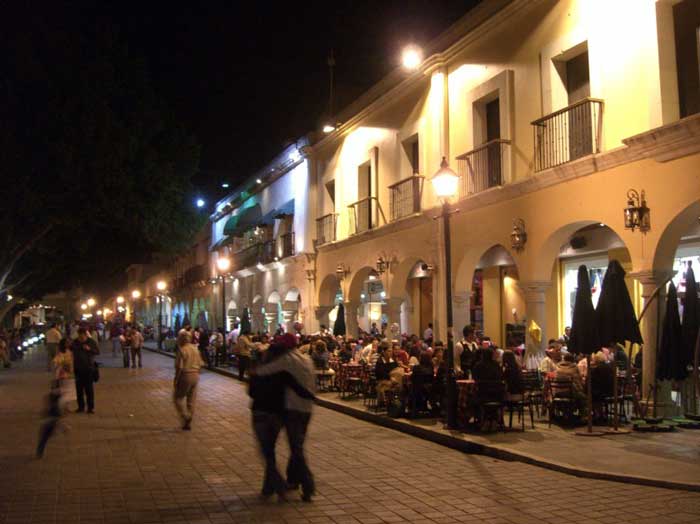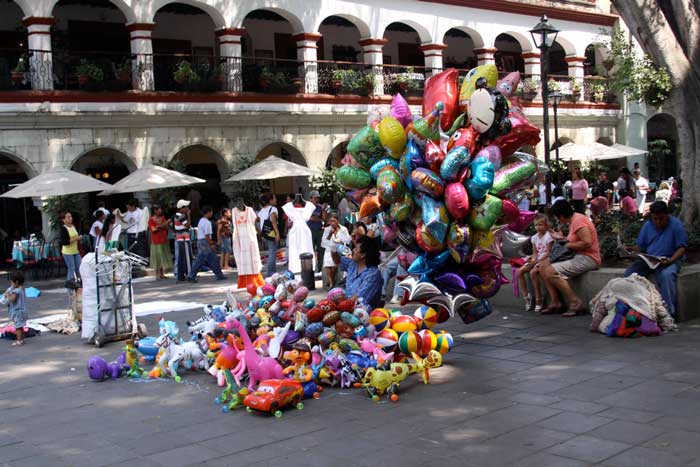|
|
The Main Plaza of Oaxaca City

Zocalo
This is the traditional central plaza of the city. As in many of the first original colonial cities of the New World, this plaza is the centre from where the rest of the streets of the city radiate out, like a checkered board.
It has on it, the grand Cathedral, seat of the Archbishopric and the Government Palace, offices of the governor of the State of Oaxaca.
It’s construction dates back to 1529 and since then it has been the focal point of the city as it is today. Totally closed off to traffic, it’s very pleasant to walk along its pedestrian walkways and sit by the cafes to watch the world go by.
Music performances take place every evening in the central bandstand, with both marimbas (xylophone) and brass bands, alternating every other evening. Also, the grand "Sunday at Noon" concert with the 70-piece Oaxacan State brass band, under the shade of the trees.
It’s also where all the parades come through, such as the Guelaguetza and the Christmas floats, as well as where all the main events are set up such as the “Grito” of Independence in September and the great Radish Festival on December 23rd.
Daily, it’s the plaza where most locals meet, walk by on their way to the old markets, look for fine dining, have drinks on the sidewalk cafes or for kids to throw up in the air beautiful balloons and enjoy our great weather under the shade of large Indian Laurel trees.

Cathedral
This is a grand structure that dominates the entire north part of the main plaza. It was established as the seat of the Bishopric and today of the Archbishopric.
It was begun in the middle of the XVI century but has undergone several constructive stages in different eras. The main façade is a remarkable early XVIII century baroque work of art. It looks as wooden altars are made inside churches but here outside and carved out of solid stone.
The Cathedral is dedicated to the Assumption of the Blessed Virgin Mary, and in its central part stands out a stone relief that shows the Virgin in full Assumption while the Disciples are looking up towards her in amazement. Some reach out with their arms trying to touch her but she’s being borne to heaven by two angels and in heavenabove awaits the Holy Trinity to crown her.
It has three doors that lead into three naves with a central choir loft and a beautiful historic organ. There are also several side chapels; the Chapel of relics, where real bones of Saints are kept, the Chapel of the Holy Cross of Huatulco and the Chapel dedicated to the Lord of Lightning (El Señor del Rayo), a major local deity.

Government Palace
From the beginning of life in the new Spanish city of Antequera, today Oaxaca in the XVI century, there was constructed a home where this building stands and used as an administrative office, to deal with the affairs of the province. Later in the XVIII century was built the first building as the one today and then another in the XIX century but due to earthquakes it was renewed and the one we see today dates from the early 1940’s.
The building faces the main plaza and it’s still today the main administrative building of the affairs of the State of Oaxaca and has the offices of the Governor and closest aids.
Great to see are the two murals that decorate the central & east stairways, painted by the renowned artist Arturo Garcia Bustos in 1980 and 1987 respectively.
The main mural in the central stairway is divided into three historic sections: pre Columbian, Colonial & Contemporary from the independence of 1810 to the revolution of 1910.
The east mural is on the lateral stairway and is painted over the small dome and walls of that smaller area. It has as a main focus the appreciation of Oaxaca’s Indian heritage and shows the pre-Columbian understanding of the creation of the universe, their perception of life & death and traditional customs that are still practiced in present day Oaxacan daily life.